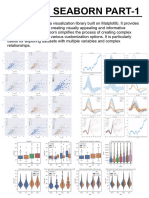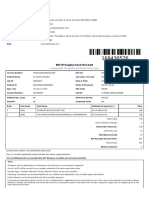Plotting with Seaborn
Seaborn simplifies the creation of fundamental plots. This subunit will
guide you through generating scatter plots, line plots, and bar plots
using Seaborn's user-friendly API (Application Programing Interface).
You'll learn how Seaborn abstracts away much of the complexity,
allowing you to create visually appealing plots with minimal code.
Let us learn to create various plots using Seaborn:
a. Generating Scatter Plots
Scatter plots are effective for visualizing the relationship between two
continuous variables. Seaborn simplifies the process of creating scatter
plots with the scatterplot() function. Let's consider an example:
# Sample data
import pandas as pd
data = pd.DataFrame({'X': [1, 2, 3, 4, 5], 'Y': [2,
3, 5, 7, 11]})
# Scatter plot using Seaborn
sns.scatterplot(x='X', y='Y', data=data)
plt.title('Scatter Plot Example')
plt.show()
Output
The Python code uses the
scatterplot() function to
create a scatter plot of the 'X'
and 'Y' variables from the
dataset.
1|Page
�b. Line Plots with Seaborn
Line plots are effective for visualizing trends in data. Seaborn simplifies
the creation of line plots using the lineplot() function. Consider the
following example:
# Line plot using Seaborn
sns.lineplot(x='X', y='Y', data=data)
plt.title('Line Plot Example')
plt.show()
Output:
The lineplot() function allows us to
visualize the trend between two
variables over a continuous axis, in
this case, 'X' and 'Y'.
c. Creating Bar Plots
Bar plots are useful for comparing categories or groups. Seaborn's
barplot() function simplifies the process of creating bar plots. Let's
explore an example:
# Bar plot using Seaborn
sns.barplot(x='X', y='Y', data=data)
plt.title('Bar Plot Example')
plt.show()
Output:
Here, the barplot() function
helps us compare the values of
'Y' for different categories
represented by 'X'.
2|Page
�Utilizing Seaborn's Simplified API (Application Programming Interface)
Seaborn provides a simplified API for common visualizations, making it
even more user-friendly. The sns.relplot, sns.lineplot, and sns.catplot
functions are part of this simplified API, allowing for easy creation of scatter
plots, line plots, and categorical plots, respectively.
Let's explore these functions with examples:
a. Create Data: Let’s first create data using pandas.
import pandas as pd
# Creating a hypothetical student_data DataFrame
data = {
'hours_studied': [4, 6, 3, 7, 5, 8, 6, 9, 2, 5],
'exam_scores': [65, 78, 50, 82, 70, 88, 75, 92, 45,
68],
'class': ['A', 'B', 'A', 'B', 'A', 'B', 'A', 'B',
'A', 'B']
}
student_data = pd.DataFrame(data)
# Displaying the student_data DataFrame
print(student_data)
Output:
The code uses pandas to
create a DataFrame
named student_data
with columns
'hours_studied',
'exam_scores', and
'class'. It then prints the
DataFrame, displaying
hypothetical student
data.
3|Page
�b. Scatter Plot using sns.relplot: Now let’s make a Scatter plot using the
data named student_data.
import seaborn as sns
import matplotlib.pyplot as plt
# Assume you have a DataFrame named student_data
# with columns 'hours_studied', 'exam_scores', and
'class'
# Create a scatter plot using sns.relplot
sns.relplot(x='hours_studied', y='exam_scores',
hue='class', data=student_data, kind='scatter')
# Add labels and title
plt.xlabel('Hours Studied')
plt.ylabel('Exam Scores')
plt.title('Scatter Plot using sns.relplot')
# Show the plot
plt.show()
Output:
This code uses the seaborn (sns)
and matplotlib (plt) libraries to
create a scatter plot. It assumes
there is a DataFrame named
student_data with columns
'hours_studied', 'exam_scores', and
'class'. The scatter plot is generated
using sns.relplot, where
'hours_studied' is on the x-axis,
'exam_scores' on the y-axis, and
points are color-coded based on the 'class' column. Additional labels
and a title are added using plt.xlabel, plt.ylabel, and plt.title. Finally, the
plot is displayed using plt.show().
In the sns.relplot function, the kind parameter is used to specify the
kind of plot to be drawn. In the provided code, kind='scatter' is used,
4|Page
� indicating that a scatter plot should be created. You can make other
plots like Line Plot and Categorical Plot using sns.relplot by changing
the value in the kind parameter.
Visualizing data directly from example datasets:
Visualizing data directly from example datasets refers to the process of
using pre-existing datasets that come bundled with the Seaborn library
for the purpose of data exploration and visualization. Seaborn provides
a collection of well-known datasets, often used in statistical analysis
and machine learning, which users can easily load and visualize without
the need for external data sources. This feature is particularly beneficial
for learning and practicing data visualization techniques. Let learn more
about it in parts:
a. Loading Example Datasets: Seaborn provides a convenient function
called load_dataset() that allows users to load various example
datasets directly into their Python environment. These datasets cover a
wide range of scenarios, from simple toy datasets to more complex,
real-world datasets. Let us consider an example using iris dataset.
import seaborn as sns
# Load the Iris dataset
iris = sns.load_dataset('iris')
In this example, the Iris dataset, a well-known dataset in the field of
machine learning, is loaded using load_dataset().
b. Exploring Dataset Characteristics: Once the dataset is loaded, users
can explore its structure, dimensions, and contents. Understanding the
dataset's features and their relationships is essential for effective
visualization.
# Display basic information about the Iris dataset
print(iris.info())
The info() method provides information about the dataset, including
the data types of each column and the presence of missing values.
5|Page
�c. Visualizing Example Datasets: Seaborn's plotting functions can be
applied directly to the loaded example datasets. This simplifies the
process of creating informative visualizations for data analysis and
interpretation.
# Create a pair plot for visualization
sns.pairplot(iris, hue='species')
In this case, a pair plot is generated to visualize relationships between
different pairs of features in the Iris dataset. The hue parameter adds
color differentiation based on the species of iris.
d. Learning and Practicing: Example datasets are invaluable for learning
and practicing data visualization techniques. Users can experiment with
various Seaborn functions and parameters, gaining hands-on
experience in creating different types of plots.
# Experiment with other Seaborn functions on the Iris
dataset
sns.boxplot(x='species', y='sepal_length', data=iris)
Here, a box plot is created to visualize the distribution of sepal lengths
across different iris species.
6|Page



















































































